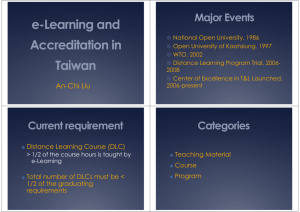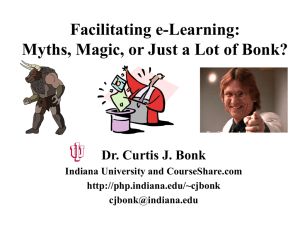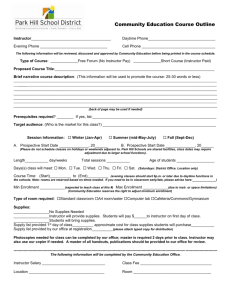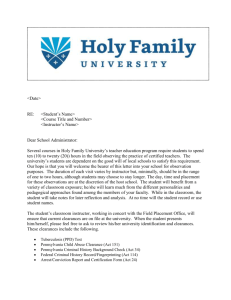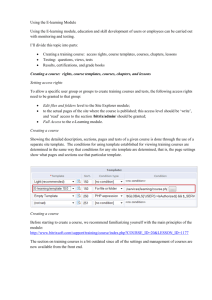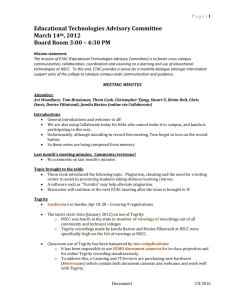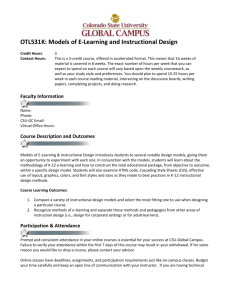Access to Online or e-learning enabled Classes at WCU
advertisement
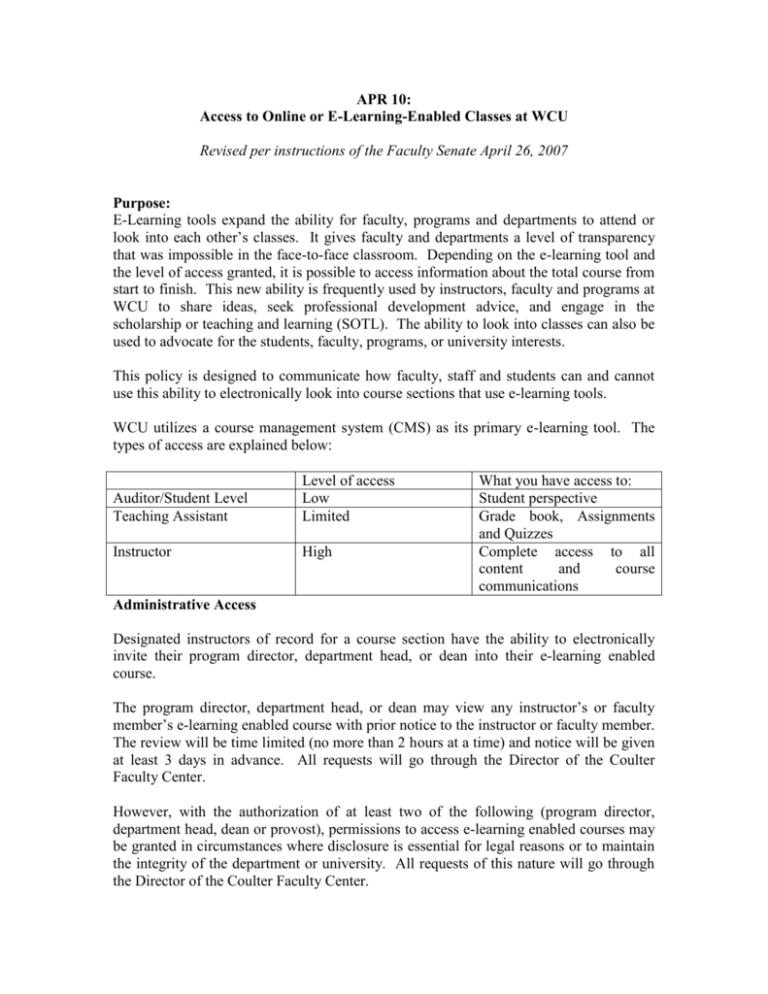
APR 10: Access to Online or E-Learning-Enabled Classes at WCU Revised per instructions of the Faculty Senate April 26, 2007 Purpose: E-Learning tools expand the ability for faculty, programs and departments to attend or look into each other’s classes. It gives faculty and departments a level of transparency that was impossible in the face-to-face classroom. Depending on the e-learning tool and the level of access granted, it is possible to access information about the total course from start to finish. This new ability is frequently used by instructors, faculty and programs at WCU to share ideas, seek professional development advice, and engage in the scholarship or teaching and learning (SOTL). The ability to look into classes can also be used to advocate for the students, faculty, programs, or university interests. This policy is designed to communicate how faculty, staff and students can and cannot use this ability to electronically look into course sections that use e-learning tools. WCU utilizes a course management system (CMS) as its primary e-learning tool. The types of access are explained below: Auditor/Student Level Teaching Assistant Level of access Low Limited Instructor High What you have access to: Student perspective Grade book, Assignments and Quizzes Complete access to all content and course communications Administrative Access Designated instructors of record for a course section have the ability to electronically invite their program director, department head, or dean into their e-learning enabled course. The program director, department head, or dean may view any instructor’s or faculty member’s e-learning enabled course with prior notice to the instructor or faculty member. The review will be time limited (no more than 2 hours at a time) and notice will be given at least 3 days in advance. All requests will go through the Director of the Coulter Faculty Center. However, with the authorization of at least two of the following (program director, department head, dean or provost), permissions to access e-learning enabled courses may be granted in circumstances where disclosure is essential for legal reasons or to maintain the integrity of the department or university. All requests of this nature will go through the Director of the Coulter Faculty Center. Other Access Faculty wishing to engage in the scholarship of teaching and learning, professional development or observation of another faculty members’ class, must have that faculty member’s permission. Access to the course should be limited to comply with FERPA regulations and protect standard privacy. Optional sources of data may include alumni, department heads, or deans (Arreola 1995, 31). In addition, as required by UNC General Administration (see Administrative Memor. #338 of 9/23/93), all non-tenured faculty must be evaluated by direct observation of classroom teaching. For the library faculty data must be included from as least the following three sources: Client assessments Faculty member’s self-report and assessment Colleagues review of teaching as defined for library faculty (relevant materials) Each of the above listed sources is defined as follows: Student Assessments Some form of student assessments must be included for each faculty member. Each faculty should obtain student assessments of at least one course each semester. In order to assure student assessment forms are reliable and valid and provide useful information, it is recommended that either a well-known commercially available student rating form be adopted or that departments carefully develop their own. For reviews of commercially available forms, guidelines for choosing a commercial form, and guidelines for developing rating forms that are valid, reliable and that provide useful information see Arreola (1995). Instructor’s Self-Report and Assessment The instructor’s self-report and assessment should address each of the seven dimensions of teaching identified in Section I. The report should be accompanied by a packet that includes items such as a statement of a teaching philosophy; a description of goals, methods, and strategies used; and selected teaching materials for the courses taught during the period of the review. For sample forms for this purpose, see Centra et al 1987, 17-20. Colleague’s Review of Teaching Teaching Materials. A department should designate for each instructor being evaluated a committee of at least two faculty colleagues, exclusive of the department head, to review and evaluate a packet of teaching materials prepared by the instructor being evaluated. Materials to be reviewed typically include course syllabi, examinations, and quizzes, reading and assignment lists, study guides, informational handouts, slides and overhead transparencies, computer programs, etc. Where feasible, reviewers should be colleagues from the candidate’s department, but, in small departments, reviewers may be selected from outside the department. Each department should develop a protocol to guide the review of materials. Reviewers may evaluate the materials in a narrative statement; a checklist developed and approved by the faculty members in the department, or a combination of narrative and checklist (see Centra et al 1987, 37-39). Direct Observation of Classroom Teaching (for non-tenured faculty only). Direct observation of teaching should only be used as a supplement to the basic data sources listed above. Because classroom observation based on a single visit by a single observer tends to be highly subjective and dependent on the observer’s biases and preconceived notions of effective teaching, it should never be used as the sole measure of teaching effectiveness. For instructors who are required to be observed, observation should be used only to verify or qualify evidence from other sources of data. It is recommended that departments select a limited set of behaviors to be observed, determine the format/scale for recording classroom observation, and select as observers colleagues who have experience or training in observational evaluation (Centra et al 1987, 21-23 and 5356).
